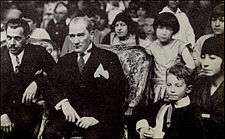National Sovereignty and Children's Day
| National Sovereignty and Children's Day | |
|---|---|
| Observed by |
|
| Type | National |
| Date | 23 April |
| Next time | 23 April 2017 |
| Frequency | annual |
National Sovereignty and Children's Day (Turkish: Ulusal Egemenlik ve Çocuk Bayramı) is one of the public holidays in Turkey and Northern Cyprus.
- "Egemenlik kayıtsız şartsız milletindir." or "Hakimiyet bilâ kayd u şart milletindir."
- "Sovereignty belongs unconditionally to the people."
- Mustafa Kemal Atatürk
Background

This national day, 23 April National Sovereignty and Children's Day, in Turkey is a unique event. The founder of the Turkish Republic, Mustafa Kemal Atatürk, made a present of April 23 to all the world's children to emphasize that they are successor of the future.[1][2] It was on April 23, 1920, during the War of Independence, that the Grand National Assembly met in Ankara and laid down the foundations of a new, independent, secular, and modern republic from the ashes of the Ottoman Empire. Following the defeat of the Allied invasion forces on September 9, 1922 and the signing of the Treaty of Lausanne on July 24, 1923, Ataturk started his task of establishing the institutions of the new state. Over the next eight years, Ataturk and his followers adopted sweeping reforms to create a modern Turkey, divorced from her Ottoman past. In unprecedented moves, he dedicated the sovereignty day to the children and entrusted in the hands of the youth the protection of this sovereignty and independence.
April 23 National Sovereignty and Children's Day
Every year, the children in Turkey celebrate this "Sovereignty and Children's Day" as a national holiday. Schools participate in week-long ceremonies marked by performances in all fields in large stadiums watched by the entire nation. Among the activities on this day, the children send their representatives to replace state officials and high ranking civil servants in their offices. The President, the Prime Minister, the cabinet ministers, provincial governors all turn over their positions to children's representatives. These children, in turn, sign executive orders relating to educational and environmental policies. On this day, the children also replace the parliamentarians in the Grand National Assembly and hold a special session to discuss matters concerning children's issues.[3][4]
Over the last two decades, the Turkish officials have been working hard to internationalize this important day. Their efforts resulted in large number of world states' sending groups of children to Turkey to participate in the above stated festivities. During their stay in Turkey, the foreign children are housed in Turkish homes and find an important opportunity to interact with the Turkish children and learn about each other's countries and cultures. The foreign children groups also participate in the special session of the Grand National Assembly. This results in a truly international Assembly, where children pledge their commitment to international peace and brotherhood.
The importance of April 23 as a special day of children has been recognized by the international community. UNICEF decided to recognize this important day as the International Children's Day.
Sources
- ↑ "23 Nisan" (in Turkish). TBMM Kültür, Sanat ve Yayın Başkanlığı. Retrieved 2015-04-23.
- ↑ "23 Nisan Ulusal Egemenlik ve Çocuk Bayramı - Mesajları ve şiirleri". Sabah (in Turkish). 2015-04-22. Retrieved 2015-04-23.
- ↑ "95 yıldır aynı heyecan". Habertürk (in Turkish). 2015-04-23. Retrieved 2015-04-23.
- ↑ "Turkey celebrates Sovereignty Day, Children's Day on April 23". Hürriyet Daily News. 2015-04-22. Retrieved 2015-04-23.
External links
| Wikimedia Commons has media related to 23 April National Sovereignty and Children's Day. |